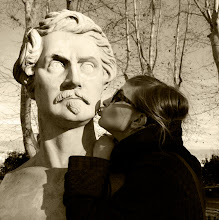7/27/09
Thesis Abstract 03: Round One!
The Bed Fables: Intimate Expanse
Place has the ability to move us. Its presence stirs deep within the constructs of memory; Ever shifting, it will not confine itself to form, but traverses all spatial boundaries, requires no language, and collapses all time; thus it is, by this nature, elusive and difficult to define. Settling itself in the identity of the individual, it resonates with one's experiential past, and therein finds its own identity. Place finds its roots within us; Place is a sense.
This thesis makes reference to the study of Place, as it is seen through the lens of the bed, and the atmosphere created therein. Jules Michelet writes, of the building of a bird’s nest, that this home is formed so intimately, by and for the body, that it is an extension of the bird itself. The bed is a repository of memory - it becomes part of the body, and as such is intrinsically tied to one's intimate identity. Gaston Bachelard refers to the house as a cradle, a refuge that appeals to our primitiveness to enclose and protect ourselves; the bed then, is a respite from the storms of waking life, and in it we find safety in the depths of sleep – it is the architecture of dreams. The bed represents that which is familiar, and comforting, or what Freud would refer to as the homely; on it we project the memories of past encounters. Through this projection of identity, it grows in meaning, and Place is born. In its intimacy, the bed is a palimpsest, a record of the life it has served. Georges Perec speaks of these objects of memory as a residue that has accumulated over the history of a life – the traces of time. The place of rest, however intimate, enclosed, and of the body it is, is also of the mind for it opens itself to the great expansive horizon of the imaginary. This thesis focuses on the Bed as it is seen through various literary voices; among these themes are those of Place, Atmosphere, the Uncanny, and the process of decay.
It is the intention of this thesis to further explore the histories, meanings, purposes, and myths that surround the idea of the Bed as Place. How is Place constructed in the imagination? Can Place be born through the traces of a life? What atmosphere is created when the objects we have such intimacy with, those which have born witness to a life, are left in abandonment, the circumstances of which are unclear? What has been the cultural role of the bed through the ages? How does the idea of the bed situate itself in literature? What are the elements of Place that surround and construct the architecture of the bed? Why can the bed carry such significance, and human identity?
The Bed As Place works both with the intimacy of the body, and with the vastness of imagination. It is a house of dreams. Auge in his essay "From Places to Non-Places" writes that place "...refers to an event (which has taken place), a myth (said to have taken place), or a history (high places)." In an attempt to answer the aforementioned questions, this thesis will put forth a book of fables of the Bed As Place, described in varying media such as essays, poetry, photography, film, and installation work, beginning with the Bed as Event, the Bed as Myth, and the Bed as History. In order to define the Bed As Place it is necessary to employ the medium of atmosphere, so as to convey an emotional understanding of the ideas discussed. It is as yet unclear what precisely this work may entail, however, in the mapping of the themes that surround the thesis, a dialogue will emerge, and with it a further understanding of Place and its role within the field of architecture.
Subscribe to:
Post Comments (Atom)

No comments:
Post a Comment